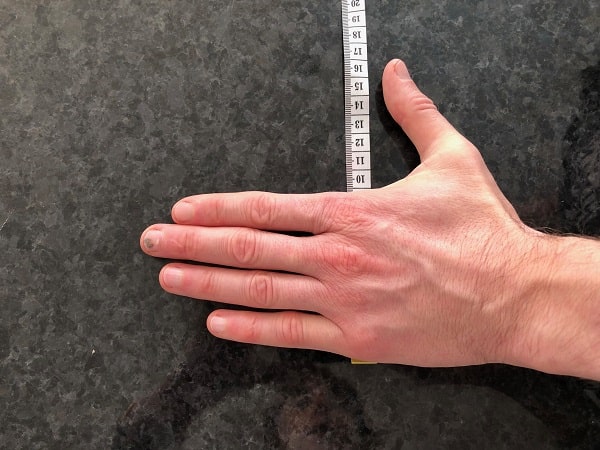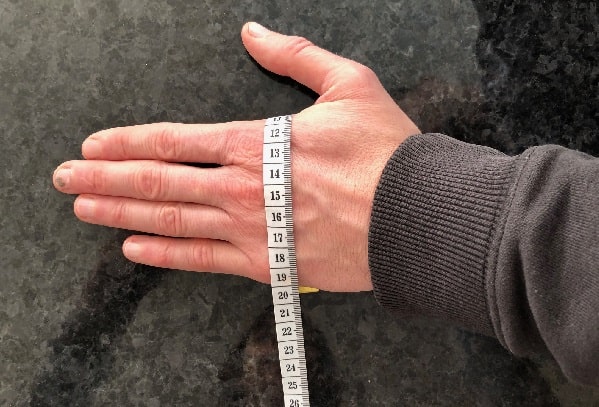Finding the right pair of motorcycle gloves can be a nightmare; not only are there all the different types of gloves on the market, but each brand also has its own sizing standards.
There is not much worse than having a bit of loose fabric at the end of the gloves, making using your indicators nearly impossible, or a pair of gloves too tight your hands hurt at the end of your ride.
This short guide will take you through how to measure your hands and other tips to ensure you get gloves that are the best possible fit.
Save Money On Your Motorcycle Insurance
- You could pay less than £195*
- Compare quotes from 25+ UK providers
- Fill in one form to compare top bike insurers
How to measure your hands
First of all, refer to the manufacturers sizing chart to give you all the important information you need.
Does the manufacturer base their sizing on width or circumference? This will usually be stated in the description and the measurements for each size bracket, i.e. S, M, L.
For example, these Richa Carbon Winter Waterproof Gloves are measured by palm width, and a size Large equates to a palm width of 9-9.5cm.
It is really important that you measure your hands rather than assuming all gloves stated to be a size Large will be the same. These Rukka Virium Gloves are also measured by palm width, but a size Large is 10-10.5cm.
Measuring Palm Width

Lay a soft tape straight on a flat surface. Place your palm down on top of it and measure the width of the widest part of your palm, not including the thumb.
Do the same for your other hand, and then use the larger of the two numbers. Compare that number to the manufacturer’s size guide, and you should be good to go.
Measuring Palm Circumference

If measured by your palms circumference, wrap the measuring tape around your palm, behind your knuckles.
Make sure it is taut to get a true measurement, and once again, don’t include the thumb.
Do the same for the other hand and again pick the larger of the two numbers when comparing to the size guide.
American and British vs European Sizing
A key indicator of how a glove will fit is to find out where the manufacturer is based.
American/British brands tend to be quite generous in the palm area and circumference of the fingers but shorter in the length of the fingers.
Whereas European brands tend to be quite narrow and tight throughout the hand and have long fingers.
It is a loose way to get an idea of how a certain brand of gloves can be expected to fit; there are, of course, exceptions to this rule.
How should motorcycle gloves fit?
Your gloves should feel snug all-around your hand and fingers. They should not pinch, bind or bunch up anywhere; these indicate the gloves are too tight or too big.
Your fingers should fill out the gloves and extend right to the fingertips of the glove.
There shouldn’t be too much loose material anywhere, including at the end of the fingertips.
Too loose?
If you have loose gloves, there is a chance they could come off in an accident and therefore offer no protection.
Loose material at the fingertips will hinder your ability to work the controls on your motorcycle.
Too tight
If your gloves are too tight, the gloves will become increasingly uncomfortable when your hands warm up and swell.
If they are textile gloves, you will have very limited stretch to accommodate this, so your hands will fatigue pretty quickly.
Test them out
The best way to know if gloves are the right fit is to try them out on your bike; if you have ordered online, just go out and sit on your bike (without actually riding anywhere) and test them out on the grips.
Do they feel comfortable? Can you work your controls? Do they gather anywhere they shouldn’t? Is your palm comfortable and fingers free?
Asking yourself these questions will give you the answers to whether they are the correct gloves for you.
Material and type of motorcycle gloves
The two main things that affect how a motorcycle glove fits are the material used and the type of glove.
There are two main materials used to make motorcycle gloves: leather and textile, usually high-density Nylon, Cordoba or other Aramid fibre mix.
It is also common to find gloves that are a hybrid mix, a combination of leather and textile.
Why glove material matters
There are just a few things to note about the materials used to make gloves that may be taken into consideration for sizing:
Leather Gloves
- Leather motorcycle gloves need to be broken in. To do this, you need to wear your gloves as often as possible, opening and closing your hand into a fist.
- The first few times on the bike may be uncomfortable, but the leather will soften and form to fit your hand after this.
- Don’t be tempted to go a size up just because the glove feels stiff; once a glove breaks in, you will be left with a loose, ill-fitting glove.
- Leather shrinks in certain conditions. If you ride in the heat and wear your leather gloves, your hands will sweat, and the leather will be warm.
- The combination of the leather being wet and hot from the sun will cause the leather to shrink a little. This should only happen in very hot weather.
Textile
- Textile gloves don’t change very much with use, so how they fit new is how they will always fit.
Types of glove
Street, Race, Dirt, Summer, Touring, Winter, ADV Gloves are just some of the types of gloves on the market.
Without going in-depth to each type of glove, here are the things to think about when buying your gloves when it comes to the type you are after and how it will affect the fit:
- Some gloves, such as touring and winter, will come up beyond each wrist in a gauntlet design. Be sure to consider your wrist size to ensure the cuff fits properly.
- Winter textile gloves can have thick thermal liners and, as a result, can come up a bit more snug than those without a liner, and they can feel quite bulky.
Be sure to check the liner doesn’t gather around the inner palm of your hand and in the crevices of fingers. This can get quite uncomfortable when using your clutch and brake levers. This mainly happens when the gloves are too big.
- Street and dirt riding gloves tend to be shorter and lighter weight. They offer greater flexibility and are generally easier to break-in.
- You need to think about the amount of armour you require to suit your riding style, as this will also affect how a glove fits.
For example, race gloves need to be made from leather and will offer heavy-duty protection, they need to fit snugly in the palm, and your fingers need to be able to work freely and precisely.
Ultimately, you will likely find yourself with multiple pairs of gloves that each have different uses.
I have three pairs, summer, winter and a pair of everyday street gloves. My winter gloves are the least comfortable due to my small hands and their bulky nature, but they keep me warm, so it is a compromise I live with.
Final Thoughts
There you have it, everything you need to consider when finding the right size motorcycle gloves.
Determine what style glove you need that will best suit your riding, account for how different materials work and the difference between European and American/British manufacturers.
After that, simply measure your hands, refer to the manufacturer sizing guide and buy your gloves accordingly.
Try them on, test them on your grips and work your controls; if all is good and as it should be, head out for some fun.
